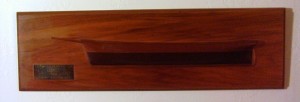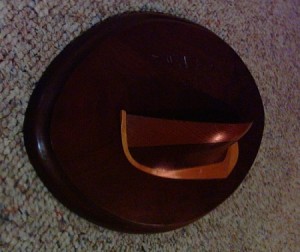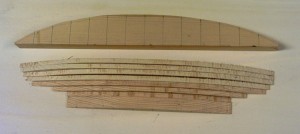Building a boat, even a small one, can be a large undertaking. Everything being relative, the size of my budget demands a minuscule boat. I remain in an extended period of constructive daydreaming. My hands, however, want to be actively constructive. I keep them busy by occasionally adding to my affordable fractional fleet. It is made up of a few vessels that have fueled my imagination in the past and I am in the process of adding a new one.
Half models have been around almost as long as boats have been assembled from individual pieces. Dugout canoes probably came along before planked craft. They did not require much preplanning in construction as they are made from a single chunk of wood. Even planked vessels did not immediately require the invention of drafting. You can still see the practice of building by hand and eye by skilled craftsmen in places were fiberglass is looked upon as frozen snot and many tools lack both power cords and batteries.
The idea of building a model prior to piecing together portions of the local forest has it’s own time honored traditions. The incentive to create more refined hull lines in search of speed and the commercial incentive to duplicate successful designs drove the practice into widespread use. An advantage of wooden hull models over paper plans is that it is a more stable medium. Paper shrinks to a surprising degree. That is why we still use tables of offsets rather than picking up measurements directly from scale drawings.
The classic method of graphically representing the shape of a vessel’s underwater form may not be easily perceived by untrained eyes. As a means of promoting a design to prospective purchasers of a ship or boat a model can’t be beat. Some of the best historical examples of this are shipyard models made for approval by the British Admiralty. These models which may still be seen in museums and private collections show a high degree of skill and artistry. They were meant to impress the Admirals on both an aesthetic and technical level. They often feature details of framing and timber work that look good but are not actually the practice that was carried out in the shipyard. These models weren’t mean to be scaled off of in the shipyard. That was probably left to more functional half models or lofting from offsets on paper plans.
As a three dimensional representation you only need to carve half of a boats hull to provide the necessary data to express it’s shape.  Measurements can be taken off at the various frame stations and laid down on the loft floor were they can be properly adjusted for accuracy and fairness. This is a search and destroy mission for errors that finds and corrects unwanted humps and hollows in the planked surfaces of a vessel. The model may be carved from a solid block or from lifts that are sawn to the shape of individual waterlines at equally spaced intervals.
I have carved quite a few half models over the years. They were a regular feature in my woodcarving business that I had during the seventies. Most of my half models have been of the block variety using two species of wood such as mahogany below the waterline and pine above. Most are finished clear but a few have been painted with detailed fittings added.
My latest build is a small display half model of L. Francis Herreshoff’s canoe yawl, Rozinante. The design has been a favorite of mine for many years. I am using the lift method which I hope will show her graceful lines to best effect. The model is fairly small at 12 inches long.. I used a library photocopier to enlarge the plans found in Herreshoff’s book Sensible Cruising Designs. The copy machine method can introduce some distortion and I don’t have any idea of the scale that results. I have no intention of being precise. The model only has to look good on a wall and be basically representative of the boats shape.
I cut the lifts from 5/16 inch stock with a bandsaw and will glue them together before carving with a selection of woodcarver’s chisels and gouges. A good low angle block plane is also handy. Final fairing will be done with with sandpaper. Templates of several stations will be used to bring the model to it’s proper form. Whether the model will include any features above the sheer line has not been determined. I hope to scrounge up an attractive piece of Cherry or mahogany to use as a back board.
There is a soothing rhythm to be found in the movement of cutting tools as they cleanly part wood fibers. The sounds are soft and inoffensive. The scent of pine is a memory trigger that transport me to other days I have enjoyed in the same happy enterprise. As the vessel takes shape beneath my hands it may set my imagination on a steady course among tree covered islands strewn with granite boulders. The laughter of the bow wave blown away by the following breeze is felt in the vibration of the tiller.
The very act of craftsmanship feeds the imagination and motivates creativity. What is modeled by the hand is molded in the mind and a cycle of satisfying thoughts spins into existence. On a winter day in my quiet shop a small ship sails in a waking dream and I am a builder of boats in my own small way.








